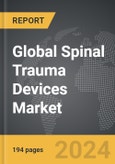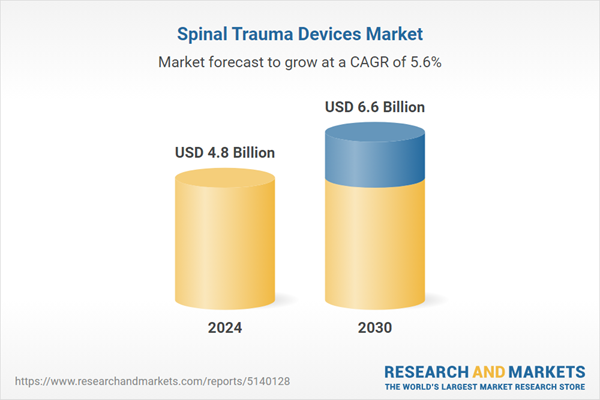Global Spinal Trauma Devices Market - Key Trends and Drivers Summarized
Why Are Spinal Trauma Devices Crucial for Modern Spinal Surgery and Recovery?
Spinal trauma devices are crucial for modern spinal surgery and recovery as they provide structural support, stabilization, and alignment to damaged or degenerative spinal segments. With the rising incidence of spinal injuries due to road accidents, falls, and sports activities, and the increasing prevalence of degenerative spine conditions such as spondylosis and osteoporosis, the demand for advanced spinal trauma devices is growing rapidly. These devices, which include spinal implants, fixation devices, fusion systems, and non-fusion devices, play a vital role in reducing pain, improving stability, and restoring function in patients with spinal trauma. The evolution of minimally invasive spine surgery (MISS) techniques has further propelled the adoption of spinal trauma devices, offering better clinical outcomes, shorter recovery times, and reduced surgical risks.How Are Technological Advancements Enhancing the Spinal Trauma Devices Market?
Technological advancements in spinal implants, fixation devices, and surgical tools are significantly enhancing the capabilities, precision, and safety of spinal trauma devices. The development of 3D-printed implants, customizable solutions, and bioresorbable materials is providing more personalized and adaptive options for spine surgeons and patients. Innovations in robotic-assisted spine surgery, image-guided navigation systems, and augmented reality (AR) platforms are gaining traction, enabling more accurate and efficient placement of spinal implants and devices. Additionally, the emergence of dynamic stabilization systems, interspinous process devices, and motion-preserving technologies is expanding the application scope of spinal trauma devices beyond traditional fusion surgeries, supporting the growth of the spinal trauma devices market.Which Market Segments Are Leading the Growth of the Spinal Trauma Devices Industry?
Device types include fusion devices, non-fusion devices, fixation devices, and decompression devices, with fusion devices holding the largest market share due to their widespread use in spinal stabilization and alignment. Procedure types comprise open surgery, minimally invasive surgery (MISS), and robotic-assisted surgery, with minimally invasive surgery being the dominant segment due to the growing preference for less invasive approaches that reduce recovery time and complications. End-use sectors include hospitals, ambulatory surgical centers, and specialized clinics, with hospitals leading the market due to their advanced surgical capabilities and multidisciplinary care teams. Geographically, North America and Europe are the largest markets for spinal trauma devices, driven by high adoption of advanced spine surgery techniques, while Asia-Pacific is expected to witness rapid growth due to increasing healthcare investments and improving accessibility to specialized spine care.What Are the Key Drivers of Growth in the Spinal Trauma Devices Market?
The growth in the spinal trauma devices market is driven by several factors, including rising incidence of spinal injuries and degenerative spine conditions, technological advancements in spinal implants, fixation devices, and surgical techniques, and the increasing focus on minimally invasive and image-guided spine surgery. The need to provide effective, reliable, and patient-specific devices for spinal stabilization, alignment, and fusion is driving the demand for spinal trauma devices across various surgical settings. Technological innovations in 3D printing, robotic-assisted surgery, image-guided navigation, and augmented reality, coupled with advancements in bioresorbable materials, dynamic stabilization systems, and non-fusion technologies, are enhancing the safety, efficacy, and marketability of spinal trauma devices, supporting market growth. The expansion of device applications in pediatric, geriatric, and trauma care settings, along with the growing emphasis on outpatient spine surgery, ambulatory care, and patient education, is creating new opportunities for market players. Additionally, the focus on developing modular, portable, and automated spinal devices for diverse surgical environments is further propelling the growth of the spinal trauma devices market.Report Scope
The report analyzes the Spinal Trauma Devices market, presented in terms of units. The analysis covers the key segments and geographic regions outlined below.Segments: Product Type (Internal Fixation Devices, External Fixation Devices).
Geographic Regions/Countries: World; United States; Canada; Japan; China; Europe (France; Germany; Italy; United Kingdom; Spain; Russia; and Rest of Europe); Asia-Pacific (Australia; India; South Korea; and Rest of Asia-Pacific); Latin America (Argentina; Brazil; Mexico; and Rest of Latin America); Middle East (Iran; Israel; Saudi Arabia; United Arab Emirates; and Rest of Middle East); and Africa.
Key Insights:
- Market Growth: Understand the significant growth trajectory of the Internal Fixation Devices segment, which is expected to reach US$4.9 Billion by 2030 with a CAGR of a 6.1%. The External Fixation Devices segment is also set to grow at 4.3% CAGR over the analysis period.
- Regional Analysis: Gain insights into the U.S. market, valued at $1.3 Billion in 2024, and China, forecasted to grow at an impressive 9.1% CAGR to reach $1.5 Billion by 2030. Discover growth trends in other key regions, including Japan, Canada, Germany, and the Asia-Pacific.
Why You Should Buy This Report:
- Detailed Market Analysis: Access a thorough analysis of the Global Spinal Trauma Devices Market, covering all major geographic regions and market segments.
- Competitive Insights: Get an overview of the competitive landscape, including the market presence of major players across different geographies.
- Future Trends and Drivers: Understand the key trends and drivers shaping the future of the Global Spinal Trauma Devices Market.
- Actionable Insights: Benefit from actionable insights that can help you identify new revenue opportunities and make strategic business decisions.
Key Questions Answered:
- How is the Global Spinal Trauma Devices Market expected to evolve by 2030?
- What are the main drivers and restraints affecting the market?
- Which market segments will grow the most over the forecast period?
- How will market shares for different regions and segments change by 2030?
- Who are the leading players in the market, and what are their prospects?
Report Features:
- Comprehensive Market Data: Independent analysis of annual sales and market forecasts in US$ Million from 2024 to 2030.
- In-Depth Regional Analysis: Detailed insights into key markets, including the U.S., China, Japan, Canada, Europe, Asia-Pacific, Latin America, Middle East, and Africa.
- Company Profiles: Coverage of players such as Arthrex, Inc., B. Braun Melsungen AG, ConMed Corporation, DePuy Synthes, Globus Medical, Inc. and more.
- Complimentary Updates: Receive free report updates for one year to keep you informed of the latest market developments.
Some of the 42 companies featured in this Spinal Trauma Devices market report include:
- Arthrex, Inc.
- B. Braun Melsungen AG
- ConMed Corporation
- DePuy Synthes
- Globus Medical, Inc.
- Medtronic PLC
- NuVasive, Inc.
- Orthofix International NV
- Rewalk Robotics Ltd.
- Smith & Nephew PLC
- Spinal Technology, Inc.
- Stryker Corporation
- Zimmer Biomet Holdings, Inc.
Tariff Impact Analysis: Key Insights for 2025
Global tariff negotiations across 180+ countries are reshaping supply chains, costs, and competitiveness. This report reflects the latest developments as of April 2025 and incorporates forward-looking insights into the market outlook.The analysts continuously track trade developments worldwide, drawing insights from leading global economists and over 200 industry and policy institutions, including think tanks, trade organizations, and national economic advisory bodies. This intelligence is integrated into forecasting models to provide timely, data-driven analysis of emerging risks and opportunities.
What’s Included in This Edition:
- Tariff-adjusted market forecasts by region and segment
- Analysis of cost and supply chain implications by sourcing and trade exposure
- Strategic insights into geographic shifts
Buyers receive a free July 2025 update with:
- Finalized tariff impacts and new trade agreement effects
- Updated projections reflecting global sourcing and cost shifts
- Expanded country-specific coverage across the industry
Table of Contents
Companies Mentioned (Partial List)
A selection of companies mentioned in this report includes, but is not limited to:
- Arthrex, Inc.
- B. Braun Melsungen AG
- ConMed Corporation
- DePuy Synthes
- Globus Medical, Inc.
- Medtronic PLC
- NuVasive, Inc.
- Orthofix International NV
- Rewalk Robotics Ltd.
- Smith & Nephew PLC
- Spinal Technology, Inc.
- Stryker Corporation
- Zimmer Biomet Holdings, Inc.
Table Information
| Report Attribute | Details |
|---|---|
| No. of Pages | 194 |
| Published | April 2025 |
| Forecast Period | 2024 - 2030 |
| Estimated Market Value ( USD | $ 4.8 Billion |
| Forecasted Market Value ( USD | $ 6.6 Billion |
| Compound Annual Growth Rate | 5.6% |
| Regions Covered | Global |









